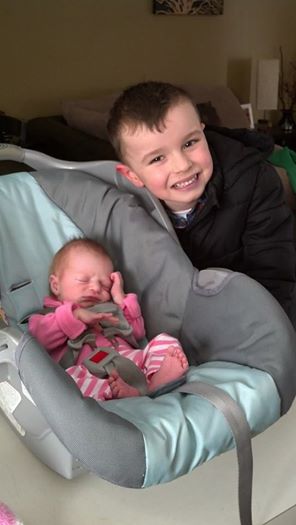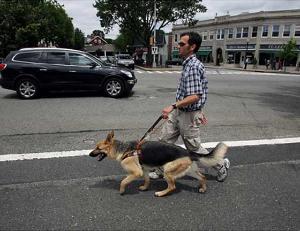Mondays with Mike: Everyday miracle
March 17, 2014 • 13 Comments • Posted in Beth Finke, blindness, guest blog, Mike Knezovich, parenting a child with special needs, UncategorizedThis week brought some good news in the Finke extended family: Ella, who had been born to Beth’s niece Stacey and her husband Ryan prematurely, came home after a stay in neonatal intensive care.
In this day and age, one can say, “No big deal.” After all, preemies are common, we have folks scheduling births to accommodate busy calendars, we have people having extravagant baby showers and now—I understand—something called “sprinkles” for babies to be born after the first child.
It’s almost as if all this childbirth stuff is routine. I’m here to tell you: It ain’t. And to confess: Every time a friend or family member reports that they are expecting a baby, Beth and I hold our breaths a little.
Don’t get me wrong: We’re happy. But our experience with Gus nearly 30 years ago taught us something about birth: as commonplace as it is, it’s a ridiculously complicated miracle that should never be taken for granted.
For those of you who don’t know the story, Gus is our son. Conceived during an enthusiastic reunion after Beth had spent months at a blind rehab facility she nicknamed Braille Jail, he was the product of what I alternately describe as major contraceptive failure or unplanned parenthood.
Beth and I did not intend to have children—largely because she was diagnosed at a type 1 diabetic when she was seven. Diabetes had already cost her eyesight, and pregnancy can cause other very serious—up to and including fatal—problems for a diabetic.
Beth had a fantastic primary care doctor who ran a battery of tests, some of which could have revealed certain problems that for us, anyway, would’ve ruled out carrying through with the pregnancy. But they all came back clean, and he explained that if she/we wanted to, and if she/we committed to a bulletproof program to manage blood sugar levels, there was no reason we could not have a healthy baby without Beth suffering for it. And so we decided to carry on.
It was months of countless finger prick blood tests and weekly (at least) doctor visits. And everything checked out along the way. Babies of diabetic mothers tend to grow large quickly, and so we knew there was a prospect of an early birth by c-section. Indeed, Gus was delivered at just over 8 lbs. about three weeks early.
“Delivered” really doesn’t do the event justice. I was there for the procedure, and will never forget the sights and, frankly smells, and, well, let’s just say placenta is pretty psychedelic. Gus came out, the doctor said we have a boy, he gave a little squawk, and proceeded to try to leave the world as quickly as he had popped into it. I got a quick glance of him, they rushed him to a table in the corner of the OR, and it was a frenzy of activity and medical talk.
Beth and I had decided that we did not want to have more than one child, and that she would have a tubal ligation after the baby was born. Our OB/GYN, smartly and responsibly, said to us: “In light of what’s going on behind me with your baby, do you still want to go through with the ligation?”
YES! was our resounding, unified chorus.
Gus was given a 50/50 chance of making it through the night. Beth was in a pain-killer induced daze, but still had the wherewithal to hold my hand and say, “However it works out, we did everything we could.”
She fell out and I went home and sat on the couch, my view a tower of disposable diapers stacked in the corner of the living room, gifts from a baby shower.
Gus was in the neo-natal intensive care unit for more than a month. The days brought good news, bad news, ups, downs. I made multiple daily visits, Beth arranged rides to visit while I was at work, it was our second home.
Apart from our own drama, what I remember most is this: Gus and we had a lot of company in the NICU. Rows of distressed babies festooned with tubes and wires in incubators, and distressed parents standing beside them. And unbelievably kind, capable staff—particularly the nurses.
We parents and doctors and nurses didn’t know a dang thing about each other but it was sort of like a college dorm. We got to know one another. We watched, with some envy, parents taking their babies home. We arrived to find a baby gone only to learn she hadn’t made it.
Gus, tough in his own way, proved to beat his odds. We eventually did bring Gus home, but only after learning he had a very rare genetic disorder that would leave him severely disabled. His difficulties had nothing to do with Beth’s diabetes.
It was impossible to understand. I saw him last week—27-year old Gus, that is. He’s doing swell in his little group home in Watertown, Wis., thanks to the good Badger and Packer fans at Bethesda Lutheran Communities.
I’d like to say all’s well that ends well. But it’s a lot more ambiguous than that. It’s still not really understandable.
One thing, though, that I’m sanguine about: When it comes to childbirth, our hubris can tempt us to believe we’re driving the bus. But we’re not. Best we can do is check the tire pressure, change the oil, and hope for the best.
Whether you believe in the wonders and complexity of biology, of God, or both (I don’t think they’re mutually exclusive), a healthy baby is one gigantic deal.
And I could not be happier for Ella and her folks.

